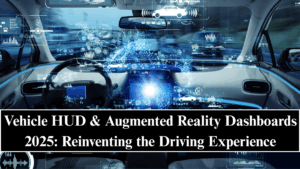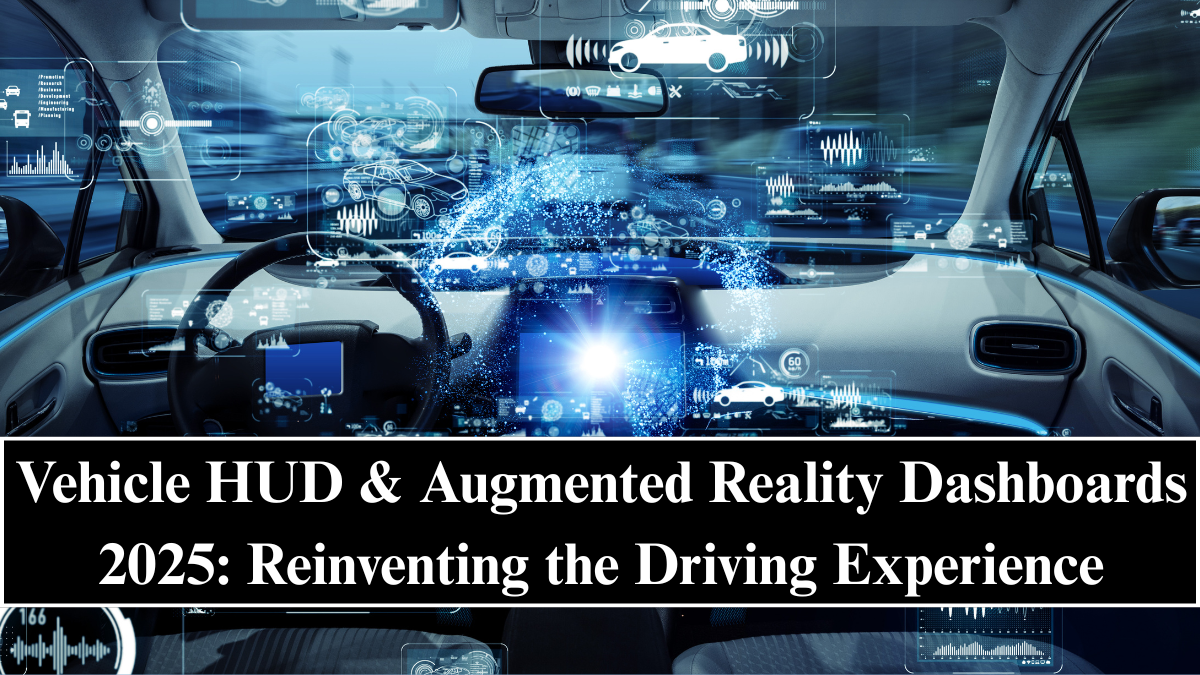In 2025, the car dashboard is no longer a static screen—it’s an interactive augmented reality (AR) cockpit that projects information directly onto the windshield. AR dashboards and head-up displays (HUDs) are transforming how drivers perceive the road, merging the physical and digital worlds to create safer, more intuitive driving experiences.

The Evolution from Screens to Smart Windshields
Traditional infotainment systems are being replaced by AR-enhanced HUDs that display critical data—speed, navigation, traffic alerts, and lane guidance—on the driver’s real-world view. This shift eliminates the need to glance away, reducing distraction and improving focus.
Instead of cluttered screens, AI-driven projection systems overlay visual cues directly on the environment. For instance, navigation arrows appear on the actual road ahead, and hazard markers highlight vehicles or pedestrians nearby.
Automakers like Mercedes-Benz, BMW, Hyundai, and Tesla are leading the charge with HUDs that feel like something out of a sci-fi movie—clear, responsive, and context-aware.
How AR Dashboards Work
AR dashboards integrate multiple technologies:
-
Cameras and sensors capture real-time road visuals.
-
AI and LiDAR map the environment in 3D.
-
Projectors or micro-displays render digital information onto the windshield.
-
Eye-tracking systems ensure that visuals align with the driver’s exact field of view.
This advanced synchronization creates a seamless mixed-reality interface, where digital elements blend perfectly into real-world scenery.
For example, when a driver approaches an intersection, the AR HUD highlights the correct lane, displays turn indicators on the road surface, and provides real-time distance to the next turn—all while monitoring pedestrian movement.
Key Benefits of AR Dashboards
-
Enhanced Safety: Drivers stay focused on the road while receiving all necessary information visually integrated into their line of sight.
-
Smarter Navigation: AR overlays guide routes intuitively, reducing missed turns and confusion in complex traffic.
-
Driver Engagement: Personalization options allow drivers to customize display brightness, layout, and alerts.
-
Reduced Cognitive Load: Simplified visuals help prevent information overload during high-speed driving.
-
Luxury and Innovation Appeal: For premium car buyers, AR dashboards have become a major selling point, symbolizing next-gen technology.
By 2025, AR HUDs are becoming standard in luxury vehicles and available as add-ons in mid-range models as costs continue to fall.
The Role of Artificial Intelligence
AI powers every aspect of AR dashboards—from object detection to contextual decision-making. The system predicts potential hazards, recognizes road signs, and even adapts to driver behavior over time.
In some models, AI can analyze facial expressions and eye movement to detect fatigue or distraction, prompting visual or audio alerts when needed. These smart interventions are saving lives by preventing accidents caused by drowsiness or inattention.
Integration with Connected Car Ecosystems
AR dashboards are not standalone features—they’re part of a connected ecosystem. Linked with vehicle telematics, cloud navigation, and V2X (vehicle-to-everything) communication, they can:
-
Display real-time traffic and weather updates directly in the driver’s view.
-
Warn of hidden obstacles beyond the driver’s visible range.
-
Sync with the car’s ADAS (Advanced Driver Assistance Systems) to create a 360° awareness interface.
This integration bridges the gap between autonomous and human driving, ensuring safety without taking control away from the driver.
Challenges and Future Innovations
Despite their promise, AR dashboards face hurdles in brightness management, cost, and driver adaptability. Ensuring visibility under strong sunlight or at night remains a key challenge.
However, 2025 models are solving this through:
-
Adaptive contrast projection that adjusts to ambient lighting.
-
Transparent OLED windshields that render crisp, high-resolution visuals.
-
5G and edge computing for faster cloud synchronization.
By 2027, experts predict that fully holographic windshields capable of displaying 3D navigation and driver alerts will become commercially viable, pushing automotive AR into mainstream adoption.
The Future of Driving: Augmented, Not Automated
While autonomous vehicles are still finding their footing, AR technology has already revolutionized driver assistance. Instead of replacing human control, it augments perception and decision-making—making driving safer, smarter, and far more engaging.
As AR dashboards become the new standard, the line between real and digital driving experiences will continue to blur—ushering in a future where cars don’t just transport us, they communicate with us visually in real time.
FAQs
What is an AR dashboard in a car?
It’s a digital system that projects real-time navigation and driving data onto the windshield, blending virtual graphics with the driver’s real-world view.
How do AR head-up displays improve safety?
By keeping vital information in the driver’s line of sight, AR HUDs reduce distractions and improve situational awareness.
Which car brands offer AR dashboards in 2025?
Brands like BMW, Mercedes-Benz, Hyundai, Audi, and Tesla have integrated advanced AR HUD systems into their 2025 models.
Do AR dashboards work in all lighting conditions?
Yes. Modern systems use adaptive projection and high-brightness microdisplays to remain visible in both sunlight and low-light environments.
Will AR replace traditional dashboards completely?
Eventually, yes. As technology matures, traditional instrument clusters will evolve into fully digital AR windshields, combining function, safety, and design.
Click here to know more.
